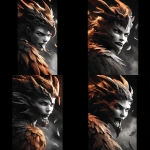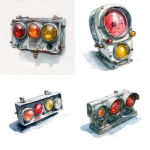Explore the Best AI Image Gallery

Quantum Creativity: Where Innovation Meets Imagination
The realm of creativity is constantly evolving, pushing boundaries and exploring uncharted territories. Today, a new force is reshaping the artistic landscape: quantum computing. This powerful technology, harnessing the principles of quantum mechanics, is poised to revolutionize how we create, experience, and interact with art and design.
Unlocking New Artistic Dimensions
Quantum computers possess an unparalleled ability to process vast amounts of data and perform complex calculations at speeds unimaginable for classical computers. This opens up a world of possibilities for artists and designers:
- Generative Art: Imagine algorithms capable of crafting intricate visual masterpieces, symphonies that evolve in real-time, or even interactive narratives that adapt to user choices based on quantum principles.
- Personalized Experiences: Quantum computing can tailor artistic expressions to individual preferences, creating unique and immersive experiences for each viewer or listener.
- Enhanced Design Tools: Architects, fashion designers, and product developers could leverage quantum simulations to optimize their creations, exploring countless iterations and refining designs with unprecedented precision.
Beyond Visual Arts
The impact of quantum computing extends far beyond visual arts. It holds the potential to revolutionize other creative domains:
- Literature and Storytelling: Quantum algorithms could generate compelling narratives with intricate plotlines, dynamic characters, and evolving storylines that adapt based on reader engagement.
- Music Composition: Imagine composers collaborating with quantum systems to explore new musical structures, harmonies, and rhythms, pushing the boundaries of sonic exploration.
- Performance Art: Quantum sensors could be integrated into costumes or stage sets, creating interactive experiences that respond to audience movement and emotions, blurring the line between performer and spectator.
Navigating Ethical Considerations
As with any powerful technology, quantum computing raises ethical considerations that must be carefully addressed:
- Ownership and Copyright: Who owns the rights to art generated by algorithms? How do we ensure fair attribution and protect creative ownership in a world of AI-assisted creation?
- Bias and Representation: Quantum algorithms are trained on data, which can reflect existing societal biases. It is crucial to ensure that creative outputs generated by these systems are inclusive and representative of diverse perspectives.
- Access and Equity: The high cost of quantum computing could create disparities in access to this powerful technology, potentially widening the gap between established creatives and emerging artists.
The Future of Quantum Creativity
Quantum computing is still in its early stages, but its potential to transform the creative industry is undeniable. As research progresses and quantum technology becomes more accessible, we can expect:
- Emergence of New Artistic Forms: Quantum-powered tools will inspire entirely new genres of art, pushing the boundaries of imagination and expression.
- Enhanced Collaboration:** Artists, designers, and developers will collaborate with quantum systems, leveraging their unique capabilities to create groundbreaking works.
- Democratization of Creativity: Quantum-based tools could empower individuals from all backgrounds to explore their creative potential and contribute to the artistic landscape.
The fusion of quantum computing and creativity holds immense promise for a future where innovation and imagination converge. As we navigate this exciting frontier, it is essential to embrace ethical considerations, ensure equitable access, and foster a collaborative environment that empowers all creators to harness the transformative power of quantum technology.

](https://images.ai-img.art/thumbnails/150/3e8c063b4357fc743a3c6e49a3145ee31b2dcecc018c38d2db8f97bf3e3fda3f.webp)
](https://images.ai-img.art/thumbnails/150/1d7b3a908141474d50d90721c394db29c0cb5404d685ae70ea60430c18e905b7.webp)

](https://images.ai-img.art/thumbnails/150/3c5dc62bba83cc9919c20ebfec8430d31e821cef586a2753dd85ef26d77d480a.webp)









](https://images.ai-img.art/thumbnails/150/8c320ce9aefbbb5b9ec5fd4e1d0fba7388f0fff5b6c2e2f14077cad3008f291d.webp)





](https://images.ai-img.art/thumbnails/150/1accb5453f2335686b162f0a879c7ce73a18516a33868f214a16bdaf95beeb5a.webp)


